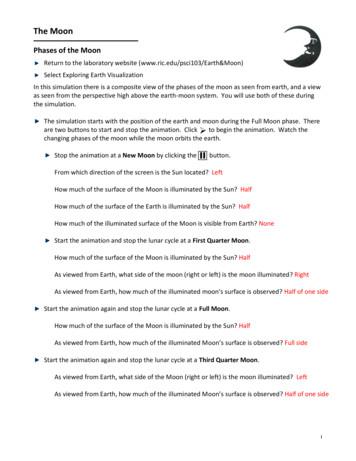Earth, Moon And Sun Systems Review - Midway ISD
8th GradeEarth, Moon andSun Systems Review
#1Click to learnWhat Causes Earth's Seasons?
#1The tilt of the earth and it’s rotation around the sunare affects that cause .A: tidesB:seasonsC: eclipsesD:daylight
B. seasons
#2When the northernhemisphere is tiltedtoward theSun, what seasonwould the northernhemispherebe experiencing?A: WinterB:C: SummerD: FallSpring
C. Summer
#3When the northernhemisphere is tiltedtoward theSun, what seasonwould the southernhemispherebe experiencing?A: WinterB:C: SummerD: FallSpring
A. Winter
#4How long toes it take the Earth to rotate onceon its axis?A: 1 yearB:28 daysC: 1 dayD:1 season
C. 1 day
#5How long does it take the Earth to revolvearound the Sun?A: 1 dayB:28 daysC: 1 yearD:1 hour
C. 1 year
#6Click to learnWhat Causesthe Phases ofthe Moon?
#7X“X” is whatphase of themoon?A: Full moonB:New moonC: 1st quarterD:Last quarter
B. New moon
#8X“X” is whatphase of themoon?A: Waning crescentB:New moonC: Waxing crescentD:Last quarter
C. Waxing crescent
X#9“X” is whatphase of themoon?A: Waning crescentB:1st quarterC: Waxing crescentD:Last quarter
B. 1st quarter
#10X“X” is whatphase of themoon?A: Waxing gibbousB:New moonC: Waxing crescentD:Last quarter
A. Waxing gibbous
#11“X” is whatphase of themoon?XA: Waning crescentB:New moonC: Waxing crescentD:Full moon
D.Full moon
#12“X” is whatphase of themoon?XA: Waning crescentB:Waning gibbousC: Waxing crescentD:Full moon
B. Waning Gibbous
#13“X” is whatphase of themoon?XA: Waning crescentB:New moonC: Waxing crescentD:Last quarter
D. Last quarter
#14“X” is whatphase of themoon?XA: Waning crescentB:New moonC: Waxing crescentD:Full moon
A. Waning crescent
#15How long doesit take themoon to showall of itseight phases?A: 2 months (60 days)B:I year (364.3 days)C: 1 month (29.5 days)D:None of these
C. 1 month (29.5 days)
#16What does the word “waxing” mean?A: Getting smallerB:Getting largerC: DisappearingD:Getting brighter
B. Getting larger
#17What does the word “waning” mean?A: Getting smallerB:Getting largerC: DisappearingD:Getting brighter
A. Getting smaller
#18The moon is like abecause itreflectslight produced bythe Sun.A: flashlightB:mirrorC: burner on a stoveD:daylight
B. mirror
Day7Day28Day14#19When the Moon isfull, it appears to bea circle.On what day isthere a full Moon?Day21A: Day 7B:C: Day 21D: Day 28Day 14
B. Day 14
Day7Day28Day14#20In the NorthernHemisphere, whatphase would themoon be on Day21?Day21A: First QuarterB:C: New MoonD: Full MoonLast Quarter
B. Last Quarter
#21If the Earth were not tilted on its axis, therewould be no .A: day or nightB:phases of the MoonC: changes of season onD:All of theseEarth
C. changes ofseason on earth
#23The Moon’sgravitational pullagainst theEarth’s gravitationalpull is the main causeofA: day and nightB:the phases of theMoonC: tidesD:All of these
C. tides
#24The gravitational pullof the Moon has agreater effect than thepull of the Sun on tides.Why?A: The Sun is larger thanB:The Sun is closer tothe EarthD:None of thesethe MoonC: The Moon is closer tothe earth
C. The Moon iscloser to theEarth
Great Job!!!!Thank you for playing!
What Causes Earth's Seasons? A: tides B: seasons #1 The tilt of the earth and it’s rotation around the sun are affects that cause _. . The Sun is closer to the Earth C: The Moon is closer to D: the earth None of these #24 The gravitational pull of the Moon has a greater effect than the pull of the Sun on tides.
5 7 6 . Which statement about the positions of the Sun, Earth, and Moon during a total lunar eclipse is most accurate? A. The Moon is between Earth and the Sun. B. The Sun is between Earth and the Moon. C. Earth is between the Sun and the Moon. D. The positions of the Sun, Earth, and Moon are
a. Sun, Earth, Moon 9) What is the position of the Earth, Sun and Moon during a solar eclipse? a. Sun, Moon, Earth 10) A complete moon cycle is how many weeks? a. 4 11) How many low and high tides occur in one day? a. 4 12) When the sun/ moon’s gravity are working together, this type of tide occurs. a.
with a New Moon, notice that the sun, moon, and earth are in alignment, with the moon in between the earth and sun. This is an angle of 0o. Since the moon orbits the earth in a counter-clockwise direction, the angle formed between the sun and moon as observed from earth increases, with the moon on the left-side of the sun. Since
Moon Orbits the Earth The moon revolves (orbits) the Earth every 27.3 days and rotates on its axis every 27.3 days. This causes the same side of the moon to always face the earth. Phases of the moon: New moon – Waxing Crescent – 1st Quarter – waxing gibbous – Full moon – Waning gibbous – 3rd Quarter – Waning Crescent - New Moon
again. The seasons change as Earth moves around the Sun. Summer turns to winter because Earth’s motion changes how energy from the Sun spreads out over Earth’s surface. The Sun The nearest star to Earth is the Sun. The Sun is about 150 million km from Earth. The Sun is much larger than Earth. The Sun’s diameter is more than 100 times .
Section 3: Exploring Earth's Moon Section 1: Earth Section 2: The Moon - Earth's Satellite. Chapter 23: The Sun-Earth-Moon System Section 1: Earth Grade 6 Earth Science . view at daybreak. Earth continues to spin, making it seem as if the Sun moves across the sky until it sets at night.
sun, earth, and moon to review important information. 14 You have learned many things about the sun, earth, and moon. In the space below draw a diagram to represent how the sun, earth, and moon appear in the solar system. Your diagram should include labels. Use arrows to represent the movement that the earth and moon make.
Earth, Sun, and Moon The Sun and Moon are Earth’s constant companions. We bask in the Sun’s heat and light. It provides Earth’s energy, and life could not exist without it. We rely on the Moon to light dark nights. Earth’s closest neighbor, the Moon, is























